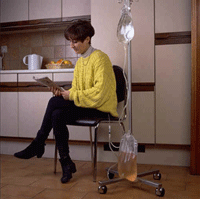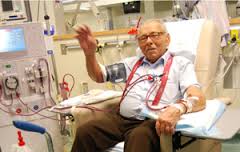PERITONEAL DIALYSIS VERSUS HEMODIALYSIS
There is not always a simple easy answer for a patient that has chronic renal disease regarding which choice or option of dialysis that is best for him or her ; so let’s investigate the options & know you can always change the choice of dialysis you initially go on. But remember you are going from a tube placed in your circulatory system to a tube now in your abdomen or visa versa (depending on what your first choice of dialysis was) and that both tubes take time to be ideally ready and final for dialysis after inserted. So definitely take consideration in your choice both for your body and time it takes to allow the tube (especially in hemodialysis) in getting at its optimal level or state in being used:
| Advantages | Limitations | |
| Peritoneal Dialysis | ·Flexible lifestyle and independence.
-Time commitment: usually less than 10 hrs per week -Time allotment: as per patient convenience -No needles -Simple techniques: easy learning -Continuous therapy: minimal fluctuation of symptoms -Once a month clinic, so no need to travel repeatedly -Easy personal travel, pack bags and go -Can use APD: connect at night and go to sleep |
Limitations are you need to weave this into lifestyle
-Abdominal catheter -Does have passive sugar intake, so need to watch for weight gain -Needs storage space of around half a closet (supplies) |
| Home Hemodialysis | -Flexible lifestyle and independence
-Time commitment: based on therapy ~ 22 hours a week -Time allotment: at patient convenience -5-6 times a week so less symptomatic fluctuations -Much higher freedom in dietary and fluid intake -May eliminate the need for BP and some of the other medications -Easy to travel with, pack and go.. |
-Needs a caregiver at least for the duration of dialysis 5-6 times a week
-Higher commitment compared to hemodialysis -Need to weave into lifestyle -Needs storage space of around half a closet -Does need AVF creation and needle access |
| In Center Hemodialysis | -Dialysis done at clinic by dialysis technicians and nurses |
-Rigid schedule, limited flexibility -Time commitment: ~20 hours a week -Time allotment: no flexibility, as per dialysis unit -Need prior authorization and arrangement for travel -Cannot travel to region not having dialysis clinic -Significant fluctuation of symptoms -Does need AVF creation and needle access -Need transportation arrangements |
More than 1/2 a million patients in USA suffer from stage V CKD commonly referred to as Renal Failure (or End Stage Renal Disease (ESRD)) with nearly similar number of patients suffering with the pre-dialysis, stage IV CKD. The management of ESRD involves either replacement of the lost kidney function through the kidney transplantation, or clearing body of the accumulating toxins through maintenance dialysis. Unfortunately, kidney transplantation is not a viable option for a majority of ESRD patients due to a limited availability of donor organs, further compounded by the fact that many of the dialysis patients are medically unsuitable for transplantation. Thus, maintenance dialysis forms mainstay of the treatment for this large majority of the ESRD patients.
- Peritoneal Dialysis (PD): This has been argued as one of the simplest form of dialysis with limited life style interruptions and high degree of freedom. In this form of dialysis a synthetic tube is placed in the abdominal cavity which then allows dialysis by exchange of dialysis fluid at regular intervals. It can be tailored to individual needs so that the patient can perform this at night while asleep with the help of a small machine called “Cycler” or during daytime by performing around four manual exchanges, each lasting around 15-30 minutes. Because of its simplicity, PD is many times a chosen modality for persons with busy lifestyle, active family responsibilities and significant time constraints.
- Home Hemodialysis (HHD): Advances in dialysis technologies in recent times has highly simplified the above-mentioned form of hemodialysis allowing it to be performed in the comforts of patients’ home. Development of smaller dialysis machine that can be placed on a nightstand; and simpler blood tubing and dialyzer connections, has resulted in increasing number of patients choosing this modality of dialysis to preserve their independence and high functional status. Though the typical duration for individual patient varies, these form of dialysis can be tailored for an individual’s needs with 5-6 times a week frequency for dialysis with each individual session duration ranging from 3-6 hours. The shorter versions called short daily hemodialysis (SDHD) whereas the longer versions are typically performed at night and thus called nocturnal hemodialysis (NHD). The typical home hemodialysis allows a much higher clearance compared to other forms of dialysis and thus gives greater freedom in terms of dietary restriction and life style choice.
- In Center Hemodialysis (HD): Where blood is taken out of the body through a complex set of tubes, run through a filter called dialyzer, cleaned off various impurities, and returned back to the patient. During its passage through the filter, the blood comes in contact with dialysate, which mirrors the body fluid except for the presence of impurities. This is conventionally performed in dialysis centers across various medical and commercial facilities and typically involves patients receiving dialysis three times a week (either on Monday, Wednesday and Friday OR Tuesday, Thursday and Saturday) with four hour session each time. This is a relatively complex form of dialysis with rigid treatment structure and limited flexibility in terms of patients’ time, mobility and transportation. Additionally, this involves creation and maintenance of vascular access such as dialysis catheter or creation of AV fistula or graft, in either arm or groin to access high flows of blood needed to perform dialysis.
It is uniformly agreed that no single type of dialysis (home Vs In-center dialysis, or Hemo Vs peritoneal dialysis) is superior to others in terms of hard clinical endpoints e.g. mortality or cardiovascular deaths. However, home dialysis modalities (both PD and HHD) provide significant advantages in multiple outcome parameters important to the management of patients with ESRD namely quality of life, freedom of travel, greater liberty from dietary restrictions, preservation of residual kidney function etc.
Historically, analyses of various patient cohorts in US have consistently revealed that; a privileged patient cohort more frequently chooses a home dialysis. This in many circumstances have been reflected by higher use of peritoneal dialysis in patients that are Caucasians, patients with higher education, patient under the care of nephrologists during the pre-ESRD period, patients receiving pre-dialysis education etc. In fact, nearly half of the patients when provided with a comprehensive pre-dialysis education (CPE) opt for home dialysis. Additionally both individual kidney physician surveys and recommendations of various professional medical societies now recommend a higher utilization of home dialysis. Despite these, only a minority of ESRD patients in US are on Home dialysis modalities. Lack of patient awareness due to lack of pre-dialysis education and scarcity of medical experts performing the home dialysis therapies are the two principle reasons for this underutilization of Home dialysis therapies.
Considering these facts, University of Florida and DCI have established a specialized clinic and education set up where a comprehensive pre-dialysis education (CPE) will be provided to the patients with stage IV (pre-dialysis) CKD along with their multispecialty care for various ailments of CKD. This clinic will put a special emphasis on the comprehensive care of CKD patients with special attention towards their dietary needs, their social and pharmacological concerns and their awareness and needs for decision making for their eventual dialysis or transplant therapies.
In conclusion of renal failure and if you are chronic, it’s not always easy to decide which type of treatment is best for you. Your decision depends on your medical condition, lifestyle, and personal likes and dislikes.
**Discuss the pros and cons of each with your health care team. If you start one form of treatment and decide you’d like to try another, talk it over with your doctor. The key is to learn as much as you can about your choices. With that knowledge, you and your doctor will choose a treatment that suits you best.**
I hope this article help you in some small way or more in dealing with your chronic renal failure. Know your not alone and have many sites and places in giving you direction and support!
| Always do a Comparison of dialysis methods : Hemodialysis and Peritoneal dialysis: |
| What is usually involved | HEMODIALYSIS
|
PERITONEAL DIALYSIS
|
| Advantages |
|
|
| Disadvantages |
|
|

